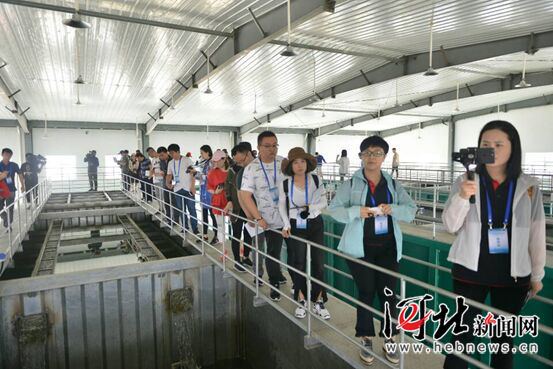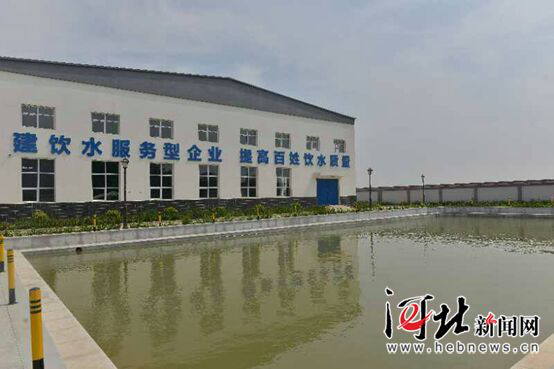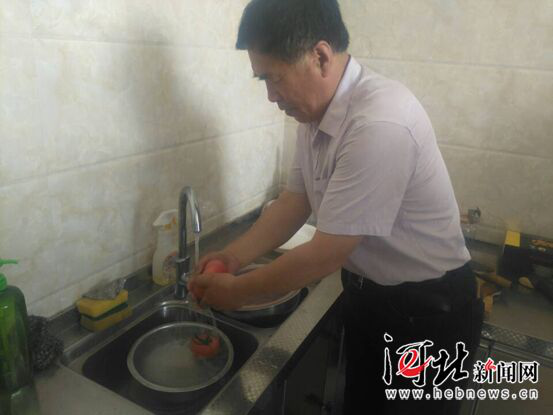
"You don't have to worry about dental fluorosis anymore," Zhao Zhixuan, a villager from Guanhe village in Botou city, told reporters of the media interview group. The media delegation visited Botou, a county-level city administered by the city of Cangzhou, to witness firsthand the changes brought about by the water diverted from the Yangtze River to the lives of local people.
In June 2017, with the completion of the auxiliary projects of the South-to-North Water Diversion Project, nine water plants in eight counties and county-level cities under the administration of Cangzhou, including Dongguang, Wuqiao, Hejian, Suning, Renqiu, Xianxian, Botou, and Qingxian, began receiving water from the Yangtze River. Since then, more than 220 million cubic meters of water has been diverted to Cangzhou, effectively improving the quality of its water supply.

On June 2, the delegation arrived at the Botou Dongxingge Surface Water Factory, which supplies water to 200,000 people in five townships, including Jiaohe town, Haocun town, Siying village, Fu town, and Xixindian village. Water diverted northward from the Yangtze River is processed here, then channeled into water distribution plants in villages and towns through pressurized pumping stations. After a second pressurization process, the water enters local homes, all with access to the water no less than 16 hours per day.
The city of Cangzhou is in the Heilonggang River basin, an area previously plagued with serious issues of high fluorine in the water. According to Liu Shengli, manager of the Botou Rural Water Supply Company, drinking water with high fluorine content for long periods will cause severe damage to the bones and teeth, even causing bone decalcification and osteoporosis. Moreover, if a large amount of fluorine is left in tooth tissues, it might cause dental enamel spots, yellow, brown or black teeth. In addition, high fluoride water also has toxic effects on the nervous system, muscles, kidneys.

According to reports, the groundwater in Botou city contains 1.8 to 2.7 milligrams of fluorine per liter, far higher than the safety standard of 1.0 milligrams per liter in China. Since the city switched to water sourced from the Yangtze River, the fluorine content per liter of water has dropped to 0.28 milligrams, and the quality of drinking water has reached the safety standard. Away from the perplexity of high-fluorine water, local people no longer worry about the related health risks, or the unsightly appearance of dental fluorosis.
Zhao Zhixuan is a resident of Guanhe village in Botou City. He and his neighbors have been drinking local groundwater for generations. "The water we used to drink tasted bitter and salty, as it has high fluorine content. If you drink it for a long time, your teeth would probably turn yellow, especially for children," he said. To help their kids avoid dental fluorosis, parents hadto buy low-fluorine water from the water factory at 1.5 yuanper barrel, and the low-fluorine water is only used when cooking and drinking.
Started from 2017, people in Guanhe Village were able to use water from the Yangtze River, and tap water was delivered to every household. "We no longer have to worry about dental fluorosis, and people are more willing to laugh," Zhao told the visiting reporters."The water now tastes good, and arthralgia and other problems caused by excessive fluoride content no longer exist."
In addition to solving the drinking water problem, the water from the Yangtze River also effectively alleviated the over-exploitation of local deep groundwater. As a serious over-exploitation area of deep groundwater, Cangzhou city was forced to shut down 17 drinking water wells and cut down groundwater usage by 3 million cubic meters. The effect of deep water recovery and water source replacement project is now readily apparent. A series of geological problems caused by the extreme decline of groundwater level have been alleviated.

At present, all the supporting projects located in Cangzhou city have been completed, and nearly 300 kilometers of water conveyance projects have been completed, including two inter-city trunk channels and 10 branch lines. Nine surface water plants have been newly built or expanded. Seven large pressurized pumping stations were constructed and 18 engineering management facilities were completed. In 2018, Cangzhou will accelerate the acceptance of those projects and complete the acceptance of all the project contracts by the end of this year.
Next, with the aid of the South-to-North Water Diversion Project, Cangzhou will implement an urban and rural water supply upgrading project. In accordance with the principle of step-by-step implementation, Cangzhou will gradually expand the scope of coverage of the South-to-North Water Diversion Project, upgrade the water supply capacity, and strive to get all people in the city to drink water from the Yangtze River by 2020.